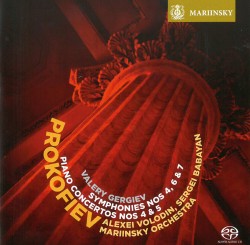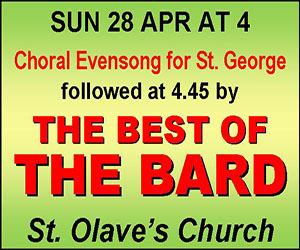 Prokofiev – Symphonies Nos. 4, 6, & 7; Piano Concertos Nos. 4 & 5
Prokofiev – Symphonies Nos. 4, 6, & 7; Piano Concertos Nos. 4 & 5
Alexei Volodin; Sergei Babayan; Mariinsky Orchestra; Valery Gergiev
Mariinsky MAR0577
The Swiss composer Arthur Honegger once claimed that Prokofiev would “remain the greatest figure of contemporary music.” These were strong words of praise indeed and whether or not one agrees, this splendid two-disc set on the Mariinsky label offers the listener ample opportunity to decide. The collection is the first in a series the label is issuing to honour the 125th anniversary of Prokofiev’s birth and features the piano concertos Four and Five and symphonies Four, Six and Seven, appropriately performed by the Orchestra of the Mariinsky Theatre with soloists Alexei Volodin and Sergei Babayan all under the direction of Valery Gergiev.
The set opens with the Piano Concerto No.4 for the left hand, music completed in 1931, and the second concerto written for the pianist Paul Wittgenstein who had lost his right arm in the Great War (Ravel had provided the first). The opening movement – the first of four – is sprightly and virtuosic, with Alexei Volodin easily handling the technical demands for the left hand that would challenge all but the most competent of artists. An expansive and introspective second movement follows a quirky Moderato before a lickety-split finale where soloist and orchestra prove a formidable pairing.
The Fifth Concerto from 1932 also presents considerable technical challenges. Its five brief movements are true studies in contrasts, from the cheeky and extroverted opening to the calm Larghetto. Throughout, Sergei Babayan’s dexterity and keyboard style are much in evidence; the virtuosic demands are conveyed with great finesse.
Judging from the relatively small number of recordings of the Symphony No.4 – originally composed in 1930 but expanded 17 years later – it would seem to be the most under-appreciated of all seven symphonies. The light and playful mood attests to its origins in the ballet The Prodigal Son on which it was based. Gergiev and the Mariinsky Orchestra provide a spirited and thoroughly convincing performance, bringing together a wealth of timbres and colours. Symphony No.6 was completed in 1947 and has long been regarded as the darker twin of the more optimistic No.5. Nevertheless, Gergiev draws a sensitive performance from the orchestra throughout the solemn march-like opening movement, the anguished and lengthy Largo and the optimistic and rambunctious Vivace, performed with panache. To a degree, the ballet spirit is also found in Symphony No.7 from 1952. The gracious second movement waltz and elegiac andante are further enhanced by the warmly resonant strings, while the spirited finale seems meant to be danced to! A surprisingly placid ending brings the symphony – and the set – to a satisfying conclusion.
In all, these are exemplary performances and the collection is destined to be a staple in the catalogue.



